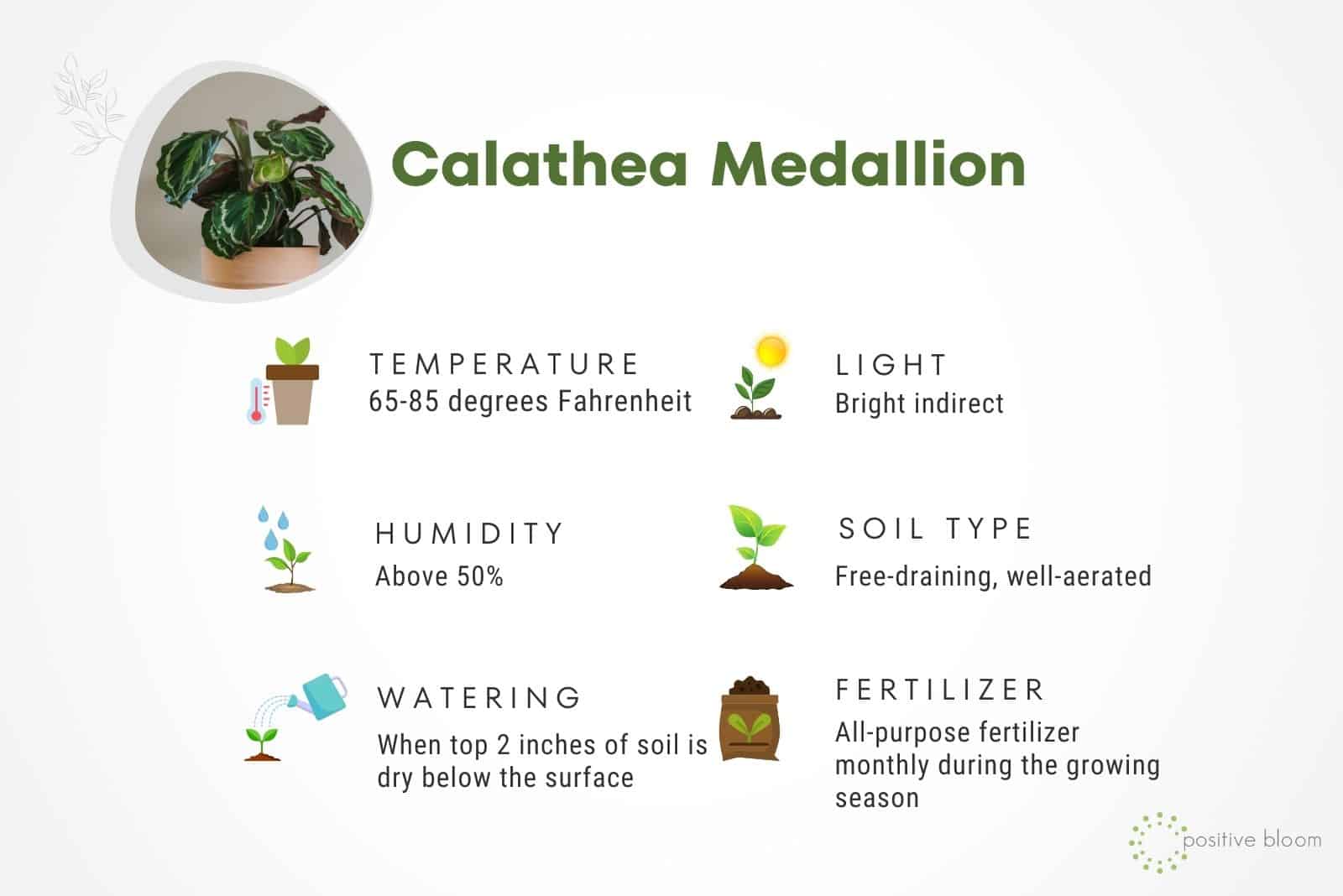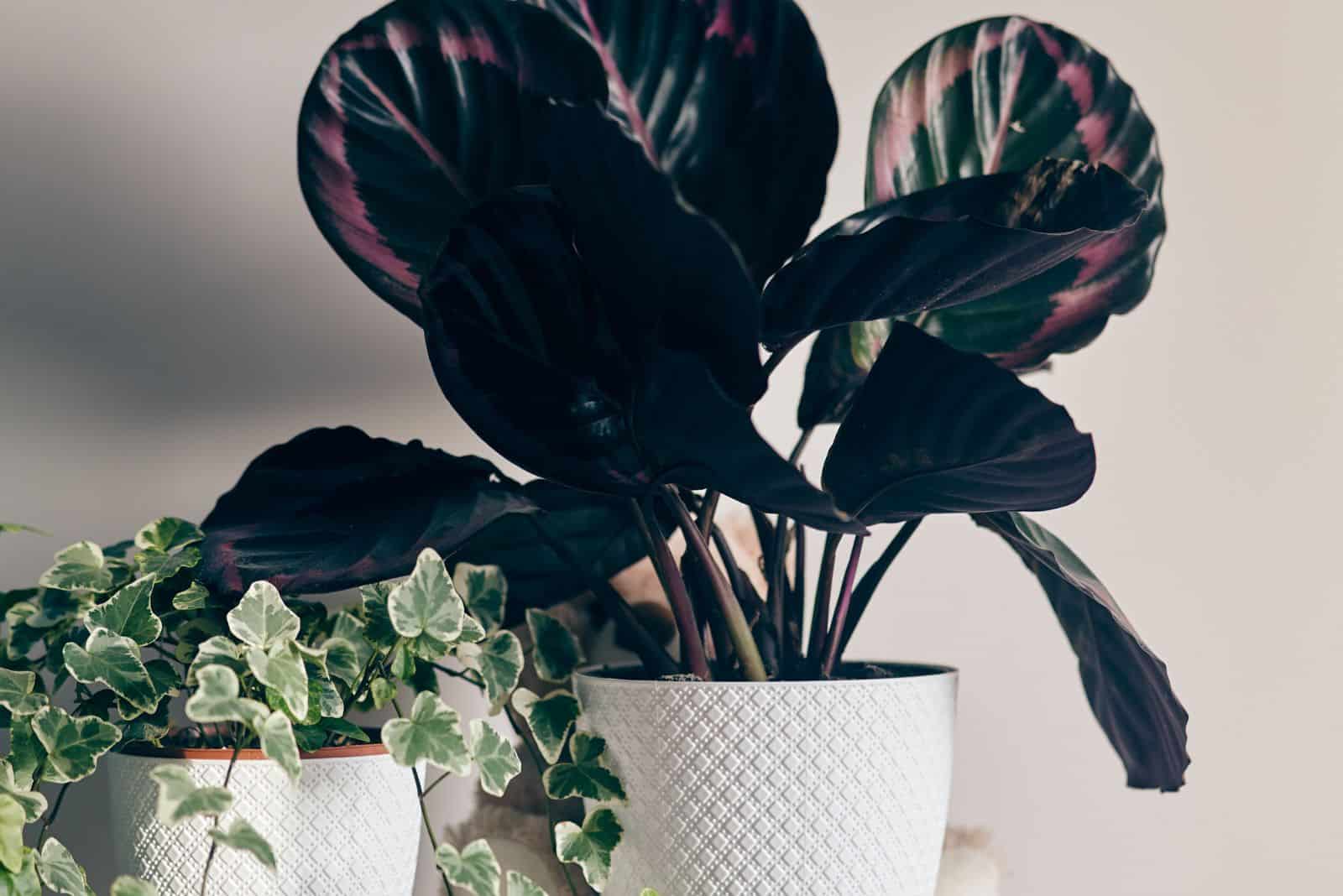Calatheas are often found in houseplant collections because of their spectacular appearance. They are also non-toxic, so they’re great for people with young children and pets.
The Calathea medallion is a beautiful species from the Geoppertia genus (formerly Calathea). Its leaves resemble medallions, hence the name. The surface of the leaves is enriched with green patterns and the undersides are either burgundy or magenta.
You’ll need to pay close attention if you want to keep this Calathea healthy, so if you are a beginner looking for a new plant, the medallion species might not be a good choice.
If you already have one or like a challenge, read on to find out everything you need to know about Calathea medallion care.
How To Care For The Calathea Medallion
Maintaining Calathea prayer plants can be challenging, especially for beginners. I often say that every growing condition must be perfect for Calatheas to thrive.
The Calathea medallion needs a lot of sun exposure, high humidity, and warm temperatures. But that’s not all; you also need to pay attention to watering, soil, and feeding.
Let’s get into details!
Light Requirements
If you want your Calathea medallion to grow healthily, you need to ensure it gets enough bright indirect light.
I highly recommend putting the medallion plant a few feet away from a south-facing window. Your Calathea will receive enough direct morning sunlight and the harsh afternoon sun won’t reach the leaves.
If you have a spot available near east- and west-facing windows, your plant will grow just fine.
Where should you avoid putting your medallion plant?
• Spots near north-facing windows don’t receive enough bright light so your Calathea medallion could lose its original colors and shape.
• Windowsills on south-facing windows aren’t good for Geoppertia plants. You need to move your lovely medallion a few feet away to avoid exposing it to direct sunlight.
• A Medallion Calathea should never be kept in a basement or similar low-light area. You must use artificial lights in this case, or you risk severe damage.
Watering
Irrigation is definitely the most challenging part of Calathea medallion care.
A rule of thumb is to water the medallion plant when the top 2 inches of the soil is dry.
You should always check the moisture content in your Calathea soil before you irrigate.
There are some helpful techniques that can help you determine moisture content. I simply put my finger in the soil. You can also use a wooden stick if you don’t like getting dirt on your hands.
You can get a moisture meter if you are a beginner and unsure about these methods.
When shouldn’t you water the Calathea medallion?
• When the soil is wet on the surface, susceptibility to overwatering and root rot significantly increases.
• When temperatures are low. During winter, your Calathea medallion is dormant and doesn’t need frequent watering.
• In the middle of the day. The worst time to water plants is in the middle of the day because temperatures are too high and water will evaporate too quickly.
Humidity And Temperature
All Calatheas enjoy humid environments because they are native to tropical regions.
When cultivated indoors, the Calathea medallion requires humidity of at least 50%.
Here are some of the best techniques for increasing humidity:
• Installing a humidifier is the safest and easiest way to raise and monitor humidity in homes.
• Misting your Calathea medallion can help you raise the humidity slightly. If the humidity in your apartment is lower than 50%, misting alone won’t be enough.
• Grouping your houseplants can help you create a more humid environment. You can combine it with misting or some of the methods below to get better results.
• Putting a humidity/pebble tray below the medallion plant’s pot can slightly increase humidity. Combine it with other DIY methods for a better effect.
• Moving your Calathea medallion to a kitchen or bathroom is another way to give your Calathea the humidity it needs.
Temperature
As mentioned, the Calathea medallion is native to tropical areas, so apart from high humidity, it also enjoys warmer temperatures.
The ideal temperature range for the medallion plant is from 65 to 85 degrees Fahrenheit.
A slightly lower or higher temperature won’t harm your medallion plant, but be careful with extremes. Calatheas are not frost-tolerant plants.
You should also be careful not to put your Calathea near heating vents, fireplaces, air conditioners, or drafty windows. Temperature fluctuations may severely damage your medallion plant.
Soil And Fertilizer
All prayer plants have the same requirements when it comes to soil.
The Calathea medallion thrives in free-draining and well-aerated soil types. Heavy soils restrict the oxygen uptake of the roots and increase susceptibility to overwatering.
You can either go with store-bought potting mixes for Calatheas or make your own. I recommend the second option.
I mix potting soil (50%), orchid bark and charcoal (40%), and pumice (10%). This combination of ingredients decreases the susceptibility to waterlogging and ensures the Calathea medallion roots have enough oxygen.
Fertilizer
Calatheas aren’t heavy feeders, but will benefit from occasional fertilization.
You can feed your Calathea medallion with store-bought, all-purpose fertilizers monthly during the growing season. If you prefer organic fertilizers, worm castings will do the job.
Never feed your Calathea more than recommended. Too much food will do more harm than good. Salt buildup in the growing medium may put your Calathea in serious danger.
Pruning
There’s no need to prune the Calathea medallion plant on a regular basis.
However, there are certain cases when pruning is a must. For instance, if you notice some yellow or brown leaves on your Calathea, you should trim them.
Discolored and diseased leaves steal nutrients and water from healthy plant parts, so removing them is the best thing you can do.
Since leaf discoloration indicates some issues are affecting the Calathea medallion, you need to inspect it further.
I’ll describe potential problems later.
Repotting
The Calathea medallion has a moderate growth rate, so you don’t need to repot it very often. I typically repot all my Geoppertias every 2 years.
The tell-tale signs your medallion plant needs repotting are stunted growth and roots poking through the drainage holes.
Here are the steps for repotting Calathea medallion plants:
1. Take your medallion plant out of the container and loosen the potting mix around the roots.
2. Examine each root and remove any that are discolored or diseased with sharp, clean scissors.
3. Take an approximately 2-inch larger container and fill it halfway up with potting soil suitable for the Calathea medallion.
4. Put your prayer plant in the center and add more soil until all the roots are covered.
5. Give your medallion plant a good soak and put it in bright indirect sunlight.
Here’s a video on how to repot the Calathea medallion:
Propagation
You can’t propagate Calatheas (Geoppertias) through cuttings. Growers are often concerned if propagating Calatheas is hard since the cutting method doesn’t work.
You can quickly propagate your medallion plant by division. This technique is simple and has a high success rate.
You can divide the mother Calathea medallion in the springtime when repotting. Here’s how:
1. The day before you repot and divide your Calathea medallion, give it a thorough watering to help reduce transplant shock.
2. Make sure to choose pots with plenty of holes in the bottom. I always put a coffee filter in the bottom of the propagation container to prevent the loss of soil.
3. Fill each container halfway up with a mixture of 2 parts peat moss or coco coir and 1 part perlite.
4. Remove old soil from your medallion plant roots gently before repotting and dividing. Separate the clump into 2-3 sections.
5. Place the parent medallion plant and divided sections into pots and backfill with more soil.
6. Water the freshly potted medallion plants thoroughly and allow the excess water to drain. Keep the plants warm and protected until they have established themselves in their new pots.
Common Issues
The Calathea medallion mainly faces issues if it grows in incorrect conditions. Houseplant pests attack weak plants that are struggling. The plant also becomes more susceptible to infections and starts displaying discolored or deformed leaves.
Let’s see more.
Pests
Infestations aren’t rare when growing plants indoors. Spider mites, scale, and mealybugs are the most frequent creatures seen on Calathea medallion foliage.
I had issues with spider mites on my medallion plant. I noticed webbing on the foliage and, upon a closer inspection, concluded that spider mites were the culprits.
Scales typically leave a sticky residue after they’re done feeding.
If you notice honeydew on the undersides of the leaves, mealybugs are most likely to blame.
You can remove, or at least reduce the number of pests by showering your Calathea medallion. Additional treatments for pests on medallion plants include insecticidal soap and neem oil solutions.
Diseases
Luckily, the Calathea medallion isn’t prone to many diseases. However, it can suffer from root rot just like all other common houseplants.
Well, we are mainly the culprits for this disease! Clay soils and overly frequent irrigation typically lead to waterlogged soil. Pathogens that cause root rot thrive in soggy soils and can kill your Calathea medallion if left untreated.
The best way to cure root rot is by repotting your Calathea medallion. Once it’s out of the pot and the root system is exposed, you need to cut off each discolored and deformed root.
Diseased Calathea medallion roots are brown or black and mushy to the touch. Always sanitize the tools you use for cutting or you risk contaminating the entire plant.
Repot your medallion plant in a fresh potting mix and dispose of the old one. Never reuse the contaminated soil or add it to the compost pile because pathogens can quickly spread.
Leaf Deformation
If the leaves of your Calathea medallion are deformed, you need to inspect your plant carefully.
If Calathea leaves are curling, drooping, and wilting, first you need to check the soil moisture content. These are the most frequent signs of lack of water in the Calathea medallion plant.
Leaf scorch typically occurs if your medallion plant is exposed to direct sunlight.
If the leaves are soft to the touch and the soil surface is mushy, you need to check the roots since this is a common sign of root rot infection.
Leaf Discoloration
If the leaves of your Calathea medallion turn yellow, you most likely overwatered your plant. Yellowing typically comes with mushy soil, foul odor, wilting, and drooping.
If the medallion plant leaves have brown tips and edges, low humidity is the most likely cause. You need to increase moisture levels using some of the ways I described above.
Here’s a video with the most common Calathea leaf problems:
Wrapping Up
Calatheas always make a good addition to a houseplant collection. Since they are not super easy to maintain, beginner growers should avoid them.
Calathea medallion care may look the same as for other houseplants, but that’s not the case. It won’t tolerate changes in growing conditions and will quickly show you if it’s unhappy.
Maintaining this Calathea is challenging but it’s worth every second you spend on it.
Until next time!



